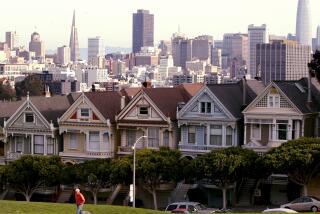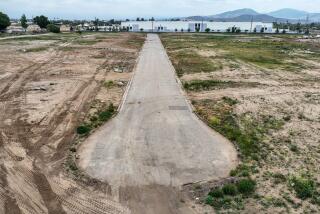Factory Homes for Customers’ Tastes
- Share via
One of our biggest problems these days is the outrageous cost of housing. There are many causes, and therefore no single solution, but a way of putting equally good houses on lots more cheaply can’t help but help.
The use of houses manufactured in factories, wholly or in great part, rather than building each house individually on its site, has been recognized as one way of doing that, and as probably the most immediately practical. A number of builders are doing that in different ways and to different extents.
A company showing a great deal of enterprise is the Select Housing Group, founded about three years ago as GW Communities and now based in Santa Ana. After getting off to a running start with the development of manufactured housing subdivisions, it saw a hole that wasn’t being plugged and unveiled the needed stopper.
The company’s first major project was reported in the real estate section Aug. 28, 1983; called Country Meadows and built in the outskirts of San Bernardino, it has sold out its 29 homes.
The company’s current projects include a two-story, 32-unit apartment complex completed in San Bernardino; a two-story, 10-unit town house project in La Palma; a 110-unit motel in Tucson scheduled to begin construction in December, and Rancho Buena Creek in Vista, where models of the single-family homes are completed. The first phase will contain 72 houses priced from about $85,000 to $108,000.
These homes are built to the Uniform Building Code (UBC). Select Homes has contracts with three companies to build them: Golden West Homes, Westway and Hallmark Southwest. But the building process is “worked backwards,” by ordinary factory building ideas.
Select Homes principal Gary Pomeroy explained that, rather than build and try to sell what the factory is used to making, they first have an architect design what the buying public wants and then tell the factory to build it. (It can cause production problems; Golden West had to raise the ceiling of the factory it had assigned to build that type of home in order to make clearance for the steeper-pitched roofs.)
But it isn’t possible to use that kind of house (called “UBC homes” in the trade) in every project, Pomeroy explained, for any one or a number of reasons, usually zoning. So Select Homes turned to houses manufactured under the federal code for mobile homes (called “HUD Code homes,” for the Department of Housing and Community Development) and contracted with Fuqua Homes in San Bernardino to manufacture them to Select Homes’ specifications. They will be used where, for one reason or another, UBC homes can’t be used.
(There’s another advantage, Pomeroy said: “We find the HUD Code homes about $1 to $3 a square foot cheaper for the builder to erect.”)
Steve Truslow, Select Homes vice president, said the HUD Code homes offer “real advantages. Developers don’t need a standing inventory since they can sell from models and since the plant (manufacturer) will accept assignments of escrow there’s no need of construction loans.” In short, the same advantages as are afforded by UBC homes.
As a result of all the factors involved--the developers’ lower costs and the economy of factory production--the HUD Code houses can be sold, excluding the land, for $31 to $36 a square foot.
Truslow explained that they are about 80% built in the factory--all the basic construction is done there, including roofs of composition or fiberglass shingles and hardboard or horizontal lap siding. Exterior stucco and tile roofs are installed on site, as are such features as bay or greenhouse windows. Fireplaces are built either in the factory or on site, depending on their location.
As with the UBC houses, Select Homes began with the design. Santa Monica architect Randall Washington designed two floor plans from which Select Homes developed two others. The four plans range from 1,000 to 1,550 square feet and have two or three bedrooms and two baths.
As Pomeroy put it: “This product does for the HUD Code what we have done for our factory-built UBC homes.”
More to Read
Inside the business of entertainment
The Wide Shot brings you news, analysis and insights on everything from streaming wars to production — and what it all means for the future.
You may occasionally receive promotional content from the Los Angeles Times.










